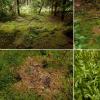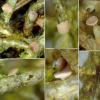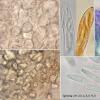
12-11-2025 09:25
 Viktorie Halasu
Viktorie Halasu
Hello, I need help with a pale terrestric Pseudom

11-11-2025 20:16
Bohan JiaHi, lastly I have found these tiny yellow decayin

09-11-2025 13:20
Hello.A tiny ascomycete, appearing as erupting gra

08-11-2025 00:29
 Francois Guay
Francois Guay
I found this species in Quebec, Canada, on herbace

Bonjour,
Je me souviens de la phrase : Namen sind halt Schall und Rauch répondant à la question d'Elisabeth dans http://www.ascofrance.fr/search_forum/55278 ...
Voici une nouvelle récolte de cette belle espèce , sur la mousse déterminée par Christian Hurtado comme Pleuroscleropodium purum.
Asques 80-1000 x 9-10 , H-, IKI R, Calycina-type. Spores 17-20 (23) x 3,5-4 Paraphyses x 3-4,5 with round VBs inly conspicuous in CRB, often forked. Extal globulosa , crystals ++.
I agree with a placement outside Bryoscyphus , including for morphological reasons . I did not clearly understand from former discussions on Ascofrance whether sequences have benn actually compared with Arachno scypha/peziza species.
Amitiés
Michel



